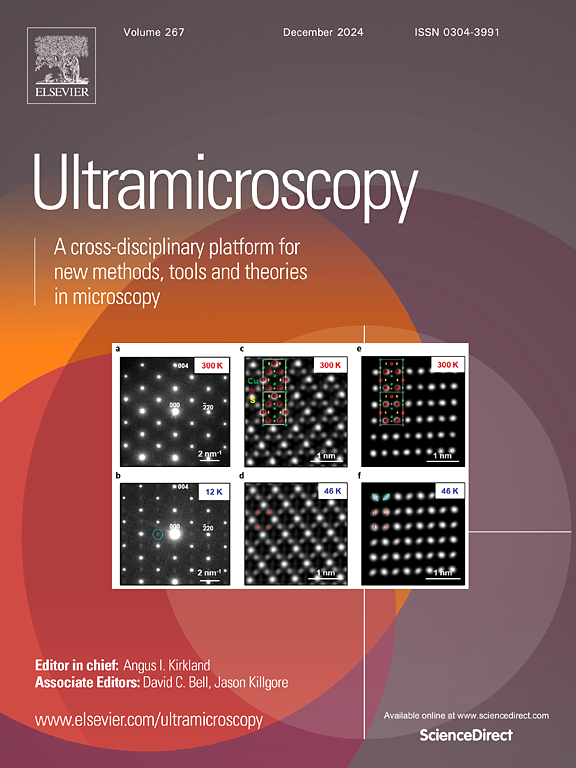Quantitative magnetic mapping in TEM through accurate 2D thickness determination
IF 2
3区 工程技术
Q2 MICROSCOPY
引用次数: 0
Abstract
Off-axis Electron Holography and Electron Magnetic Circular Dichroism are powerful Transmission Electron Microscopy (TEM) techniques capable of mapping magnetic information with near-atomic spatial resolution. However, the magnetic signals obtained is semi-quantitative due to factors such as thickness variations and local crystallographic changes. Precise determination of spatial thickness variations can make these techniques more quantitative. Electron Energy Loss Spectroscopy (EELS) provides a method to measure thickness variations within a region of interest. The absolute thickness depends on reliable estimates of the inelastic mean free path (), which is often unknown for many materials. Alternative techniques, such as Scanning Electron Microscopy (SEM) and Convergent Beam Electron Diffraction (CBED), either lack spatial resolution in thickness mapping or are accurate only within a limited thickness range. Here, we present a straightforward approach to precisely determine the inelastic mean free path (), enabling accurate thickness measurements from EELS maps. We compare these thickness measurements with CBED- and SEM-based methods, identifying discrepancies, particularly in thinner samples (). Finally, we demonstrate how this calibrated thickness measurement can provide quantitative magnetic maps using TEM-based magnetic measurements.
通过精确的二维厚度测定,在TEM中进行定量磁成像
离轴电子全息和电磁圆二色是一种强大的透射电子显微镜技术,能够以近原子的空间分辨率绘制磁信息。然而,由于厚度变化和局部晶体学变化等因素,获得的磁信号是半定量的。精确确定空间厚度变化可以使这些技术更加定量。电子能量损失谱(EELS)提供了一种测量感兴趣区域内厚度变化的方法。绝对厚度取决于对非弹性平均自由程(λ)的可靠估计,这对于许多材料来说通常是未知的。其他技术,如扫描电子显微镜(SEM)和会聚束电子衍射(CBED),要么在厚度映射中缺乏空间分辨率,要么只能在有限的厚度范围内准确。在这里,我们提出了一种简单的方法来精确确定非弹性平均自由程(λ),从而可以从EELS图中精确测量厚度。我们将这些厚度测量值与基于CBED和sem的方法进行比较,发现差异,特别是在较薄的样品(100nm)中。最后,我们演示了这种校准厚度测量如何使用基于tem的磁测量提供定量磁图。
本文章由计算机程序翻译,如有差异,请以英文原文为准。
求助全文
约1分钟内获得全文
求助全文
来源期刊

Ultramicroscopy
工程技术-显微镜技术
CiteScore
4.60
自引率
13.60%
发文量
117
审稿时长
5.3 months
期刊介绍:
Ultramicroscopy is an established journal that provides a forum for the publication of original research papers, invited reviews and rapid communications. The scope of Ultramicroscopy is to describe advances in instrumentation, methods and theory related to all modes of microscopical imaging, diffraction and spectroscopy in the life and physical sciences.
 求助内容:
求助内容: 应助结果提醒方式:
应助结果提醒方式:


